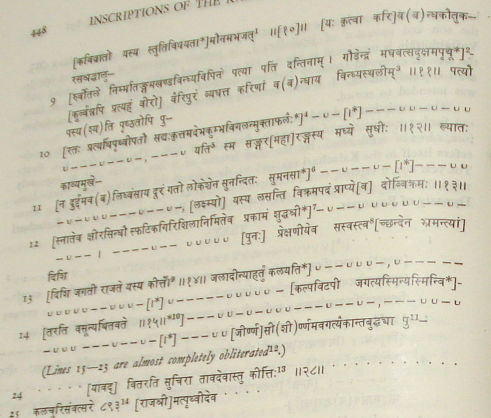|
INSCRIPTIONS OF THE KALACHURIS OF RATANPUR

TRANSLATION
(Verse 1) (This verse is completely lost.)
(V. 2) [There was (the king) Jājalladēva (I) who equalled the sun's lustre, who was
a ruby in the chaplet on the head of the Kalachuri lineage] (and) the charm of whose
body was caused by the envious side-glances (clearly) manifested by the graceful play of
the eyebrows of the goddess of victory during fighting.
(V. 3) His crowned queen was Lāchchhalladēvī, who was his lawful and only
___________________
1 Metre: Śikhariṇī.
2 See 1. 9 of the Raipur Museum inscription.
3 Metre of this and the next two verses: Sārdūlavikrīḍīta.
4 See 1. 10 of the Raipur Museum inscription,
5 Perhaps भुययति is intended.
6 These aksharas are supplied from 1. 11 of the Raipur Museum inscription.
7 Loc. cit., 1. 12.
8 Read शश्वत्स्व.
9 See 1.13 of the Raipur Museum inscription. Metre: Sragdharā.
10 See 1.14 of the Raipur Museum inscription. Metre: Śikhariṇī.
11 This verse occurs also in 11. 17-18 of the Ratanpur inscription of Pṛithvīdēva II (below, No.
95). Metre : Śārdūlavikrīḍita.
12 At the end of 1.17 the aksharas अचीख - can be read clearly, which shows that like the
Akaltarā
inscription, the present inscription also contained a description of the tank excavated by Vallabharāja.
13 Metre: Sragdharā.
14 The first figure of the date is somewhat indistinct, but that it cannot be anything but 8 is clear
from the dates of Nos. 86-96 which belong to the reign of Pṛithvīdēva II..
Home
Page |